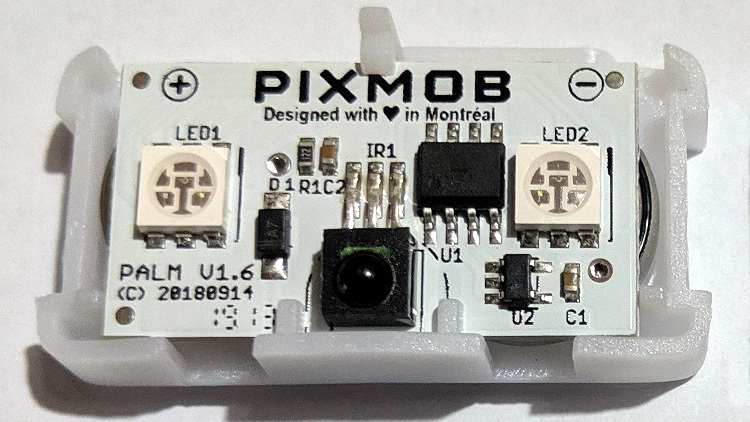PixMob units are wearable LED devices intended for crowds of attendees at events like concerts. These devices allow synchronized LED effects throughout the crowd. [yeokm1] did a teardown of one obtained from a preview for the 2019 Singapore National Day Parade (NDP), and in the process learned about the devices and their infrastructure.

PixMob hardware has been known to change over time. This version has two RGB LEDs (an earlier version had only one), an unmarked EEPROM, an unmarked microcontroller (suspected to be the Abov MC81F4104), and an IR receiver module. Two CR1632 coin cells in series power the device. [yeokm1] has made the schematic and other source files available on the teardown’s GitHub repository for anyone interested in a closer look.
One interesting thing that [yeokm1] discovered during the event was the apparent source of the infrared emitter controlling the devices. Knowing what to look for and reasoning that such an emitter would be mounted with a good view of the crowd, [yeokm1] suspected that the IR transmitter was mounted on a lighting tower. Viewing the tower through a smartphone’s camera revealed a purplish glow not visible to the naked eye, which is exactly the way one would expect an IR emitter to look.
Sadly, there wasn’t any opportunity to record or otherwise analyze the IR signals for later analysis but it’s possible that the IR protocol might be made public at some point. After all, running custom code on an earlier PixMob board was made possible in part by asking the right people for help.
















They should scan the emitter like the HTC “lighthouse” tracking system, so they can spatially address “clumps” of “pixmobsters”(?) and use the crowd like a large, low-res display.
Nice idea but I don’t think that would work well enough with IR to form a display because IR reflects too good from to many surfaces.
You’d always get quite a lot stray “hixels” (human pixels) lighting up when they’re not supposed to (imho).
You may have a point, but the lighthouse system seems to work. Plus, it’s not exactly a critical application, so a few extra hixels (good term!) wouldn’t be a deal-breaker.
And if the venue is a Country-Western concert, are they hick hixels?
B^)
So, do hick hixel hackers exist?
B^)
In a Country-Western concert the hick hixels get told when to hold up their flaming torch.
Wouldn’t work with that tiny micro. The lighthouses sweep the room periodically with a laser beam, but it’s the device itself that calculates its own location by timing when it gets hit by the beam in correlation with a global (omni-directional sync pulse from a more normal IR led). So it’s not the base stations that are super smart, but the device itself.
This is literally what they do.
We had these at a concert i went to recently, and had a couple that were thrown away outside of the venue, where they had recycling points for these for reuse.
Yes, IR TX were used at that concert too, and they were able to direct signals for activation, with the results being Mexican waves radiating out from the stage around the audience clockwise and anti clockwise. There was no other way they had been able to ‘location register’ each band in order to transmit a large signal, so it had to be directional. the band of light were several meters wide.
“with the results being Mexican waves radiating out from the stage”
Hopefully the were friendly Mexicans.
Not sure that type of comment was needed.
Hey! I just saw they are now using moving head lights to control those. As a stage technician 2hrs from Montreal I’m hyped. I tried to contacted them for some info :)